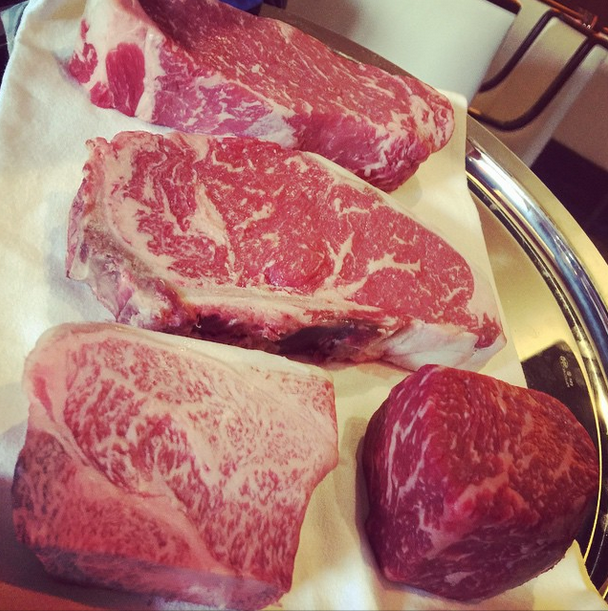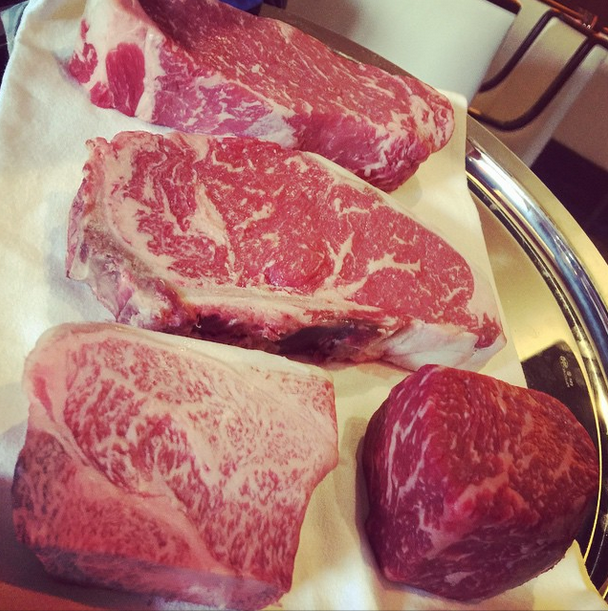What’s a food worth? That seems to be the question I get most when I rave about a recent meal I had at Stake Chophouse & Bar, the new modern steakhouse in Coronado. The restaurant is impressive, a white leather rooftop perch in the former Ristorante La Terazza. It boasts chef Tim Kolanko, the longtime right-hand man of Jeff Jackson at A.R. Valentien, and Greg Majors, former beverage director at Tom Colicchio’s Craft Restaurant in NYC. They serve an excellent citrus salad with citrus, pomegranate, beet, turnip, romaine and watercress. Their steak tartare with potato chips, quail egg and cornichon is a perfect mix of the meat’s natural tenderness and fat, the acid from the cornichon, the silky “sauce” of the yolk and the salt-crunch of the potato chip. Their foie gras with quince, apple and frisee on a buttery crostini is one of the best bites of food you will ever put in your mouth—the panna cotta-like texture of the fatty duck liver offset by the sweet-sharp fruit.
But it’s the A5 Japanese Wagyu people have asked me about the most. True Japanese Wagyu beef comes in various grades for quality, and A5 is the highest you can possibly get. The server presented the raw beef to us on a plate—dry-aged ribeye, filet mignon, and Wagyu among the cuts.
The Wagyu is immediately identifiable. While the other cuts marbling here and there, the Wagyu is almost white, a sort of impressionistic painting of red meat and pearly fat. Steak experts always talk about “marbling.” The A5 is beyond marbled. It’s snowed.
We were served three ounces of A5 Wagyu—at $28 an ounce, the cost is $84.
“Jesus!” friends have balked. “For three ounces?! No food is worth that!”
Yes, it is. This food is. There’s a primal moan most omnivores are familiar with. That first bite of a truly good steak—a tidal wave of umami that hits the pleasure center on a million years of omnivorous evolution. Take that moan, multiply it by five moans, and that is the experience of each bite of A5 Wagyu. The bite is soft, almost spongy, on account of fat. It straddles the line between a steak and the meat-butter lusciousness of foie gras. You eat it slowly. You let it linger on your tongue. You roll your head around and act in ways inappropriate of your refined setting.
It is that good.
The restaurant suggests three ounces. But I could honestly justify ordering one or two ounces (anything more than three ounces would be far too much of a rich food). Of course “worth” depends on one’s personal economy. I couldn’t afford to pay $28 an ounce for meat on a regular basis.
That said, I would absolutely pay $52 or even $84 once a year for two to three ounces of this food. I have paid $84 or more for an entire dinner. Many, many times. And the eating experience of those three ounces of A5 Wagyu blew most of those entire dinners out of the water. It’s god food.
America has a long history of over-valuing quantity in its analysis of a food’s worth. In the case of A5, its astronomical quality overrides any desire for a traditional American “meal”—meaning, a mountain of food. A5 Wagyu is not meant to be eaten every day or every week or even every month. It should, however, be eaten before your time is through.

PARTNER CONTENT
Guess which one is the Wagyu?












